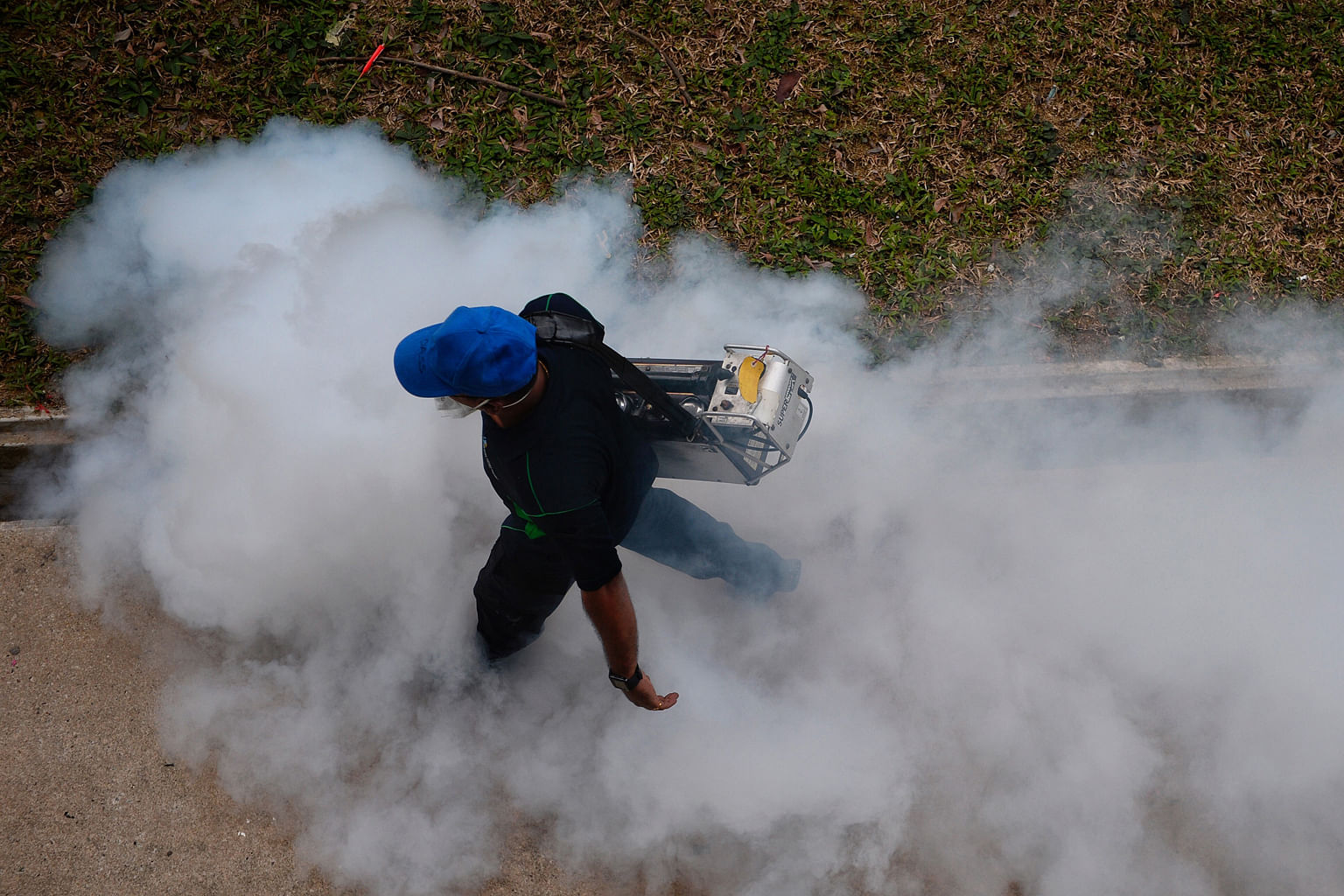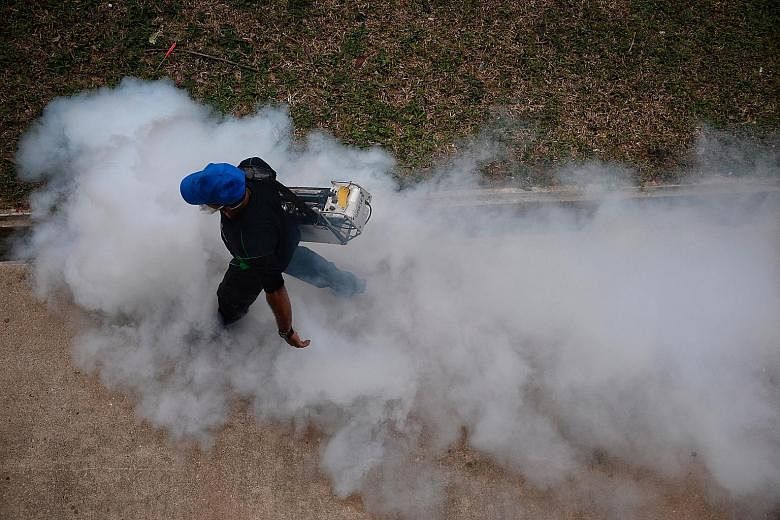The first-known local transmission of the Zika virus took place in the Aljunied area, right smack where one of my friends lives.
Within minutes of the news being out, the WhatsApp group of my friends came alive with comment and commiseration.
The next day, my friend reported: "Now my place looks like a disaster zone. A lot of workers checking drains and houses. Fumigation has been going on for past two hours. Everyone in the neighbourhood has only one topic for conversation. Panicky mood."
We traded tips on mosquito prevention and repellents to buy. My Aljunied friend added the next day: "We can no longer distinguish between haze and fogging here."
Even without emoticons, her wry observation cracked us up.

Because the virus had hit an area where one of us lived, my friends and I started to read up on Zika and shared information.
Like many Singaporeans, I followed news of the Zika spread with interest, and some anxiety. But it remained a virus that was "out there".
Then Zika struck home.
I opened the papers on Friday morning to read that Zika had been found in someone living in Tagore Avenue off Upper Thomson Road, close to where I live.
The Ministry of Health did not give any information on the new case, except to say there were no known links to existing clusters. Tagore Avenue is an industrial - not residential - estate.
The only people living there that I know of are foreign workers in dorms among the factory buildings. I figured it was likely a foreign worker who was infected. But it actually doesn't matter where, or how, he got infected.
In fact, despite some hoo-ha on the issue online, it doesn't even matter when Zika first came to Singapore, or how, or who the initial patient was.
This is because Zika is primarily passed by mosquitoes. It is not known to be passed via airborne transmission from one person to another, from breathing in infected droplets and such. The only way it is passed from human to human is through sex.
Knowing who Patient Zero is is important if a virus is spread by airborne transmission from one person to another, because you can then trace all the patient's contacts and try to isolate them before the disease spreads further. This worked with Sars.
However, Zika is carried by the Aedes aegypti mosquito. This troublesome species, which is also responsible for dengue and chikungunya, is rampant in Singapore. It bites a person carrying the Zika virus, and then passes it on to another person it bites.
Beyond the sadistic pleasure of finger pointing, I am not sure what can be gained by finding out who the first patient was.
One might as well try to trace the first mosquito that bit an infected person!
In any case, most people carrying the Zika virus have no symptoms. So it would be impossible to find out who the first person responsible for local transmission was.
We do know that the first case of reported imported infection was in May, when a 48-year-old permanent resident living in Watten Estate was found to have Zika. He was in Brazil from March to May, so the case was considered an imported transmission.
The first reported local transmission was on Aug 27. Within days, the number of confirmed cases shot up. As of yesterday, there were 215 confirmed cases.
Several countries have been swift to issue travel advisories, with South Korea, Australia, Taiwan and the United States warning pregnant women or those trying to get pregnant to avoid travelling to Singapore. Tourism will likely be hit to some degree, as honeymooners and other women of childbearing age put off discretionary travel here.
When I looked at the map of Zika transmissions worldwide, I wondered if Singapore was paying a price for its fast, efficient response.
Since most people carrying the virus have no symptoms, the virus is likely to spread quietly in a locality if you don't test people for it. It draws attention only when many people surface with symptoms.
The virus may also become known to be widespread only months later - when some pregnant women report babies with microcephaly, a neurological disorder which gives babies smaller-than-normal heads.
The other sign of active Zika virus in a community is when more people than usual develop Guillain-Barre syndrome, an autoimmune disorder.
In other words, unless you are actively testing for it, it could take several months before you know the virus is actively circulating in a city.
You won't know how many citizens in your country have the Zika virus if you don't test them for it.
Singapore has been proactive in getting residents tested once a case has been confirmed in a neighbourhood. It has a network of vigilant general practitioners looking out for people with the Zika symptoms of fever, rash and body ache or headache.
Singapore has released details of foreign nationals living here who got Zika. If some of them return home and pass Zika to others, fingers will point at the Republic.
Ironically, by being proactive and open with information on transmission, Singapore will likely draw attention as the centre of a web of possible transmissions.
There are probably plenty of other transmissions going on in other countries with the Aedes aegypti mosquito, but because the health authorities aren't actively checking or diagnosing them, they won't show up till months later.
Meanwhile, we are in the hot seat.
Figuring this out made me feel mildly depressed and bad for Singapore. We are one of the cities in the region taking the virus seriously and trying to control its spread, but risk becoming better known as the centre of future spreads.
Even the US Centres for Disease Control and Prevention director Tom Frieden said it was watching Singapore closely: "Any time there is a disease outbreak in Singapore, it tells us how difficult that disease is to control."
According to a report on NBC news on Thursday: "That's because Singapore has a tight system for controlling disease. It made Zika a notifiable disease, meaning any doctor who diagnoses a Zika case must inform the Government. What impresses Frieden is Singapore's team of inspectors, who keep an eye out for the standing water that breeds mosquitoes."
They are National Environment Agency inspectors, working with grassroots leaders as they go into factories and homes to look for and destroy mozzie-breeding sites.
From a virus I followed out of professional interest as a journalist, to concerned interest when it struck near my friend, Zika became personal on Friday morning when I realised the virus was next door to my home.
Time to get off my keyboard warrior mode into active mozzie-fighting mode. I read my colleague Salma Khalik's battle cry to every Singaporean to fight the mozzie battle:
"If just one family living in a block of flats allows mosquitoes to breed, perhaps in a pole holder, in a vase of cut flowers or even in the rim of an upturned pail, it will negate the efforts of families living in all the other flats in the block."
My pails are usually upturned. But could there be water collecting in the rim of an upturned pail? This was a new one. I had to check it out.
In my bathroom, the upturned pail and basin - and rims - were all dry. So was the soap dish.
But then - horrors - a plastic tray that held my shampoo and conditioner has a flat, solid base of a few millimetres, and it was full of stagnant water and bits of dark swirls that could be larvae.
I dumped out the water immediately.
In the fight against the dreaded Aedes mozzie and Zika, we can be armchair critics, sitting with judgmental crossed arms as we fault the authorities for not doing enough, not being fast enough, and hurl baseless accusations that they are hiding information.
Or we can give credit where it is due, and encouragement to our fellow citizens out there fogging, knocking on doors, visiting homes of bo-chap (can't-be-bothered) citizens to suss out mozzie- breeding grounds.
More than that, we can join in the fight.
Check your own home and work premises. Cap bamboo pole holders when not in use. Change water in vases and bowls every other day.
Turn over pails and basins. Check for water in containers like plant pot bases, rims of upturned pails, and - my Achilles' heel - the tray that collects water underneath dish drainers.
In so doing, we protect ourselves, our neighbours, and - most of all - future babies.
The fight against the dreaded Aedes mozzie has to get personal, and we should all start taking it seriously before it strikes home.


